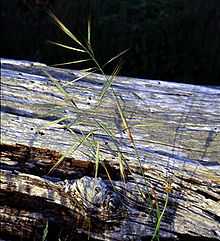Bromus diandrus
| Bromus diandrus | |
|---|---|
 | |
| Scientific classification | |
| Kingdom: | Plantae |
| (unranked): | Angiosperms |
| (unranked): | Monocots |
| (unranked): | Commelinids |
| Order: | Poales |
| Family: | Poaceae |
| Genus: | Bromus |
| Species: | B. diandrus |
| Binomial name | |
| Bromus diandrus Roth | |
Bromus diandrus is a species of grass known by the common names great brome and "ripgut brome".
This is a brome grass which is native to the Mediterranean but has been introduced to much of the rest of the world. It does best in areas with a Mediterranean climate, such as California and parts of southern Australia, but it is quite tolerant of many climates.
The adult plant is one to three feet in height with hairy, rough leaves about a centimeter wide. The membranous ligule is prominent, white in color with spiky hairs. The wide panicle nods like that of an oat plant, and it bears a large, splayed spikelet with a very long awn which can exceed five centimeters in length. The seeds easily break out of the spikelet. They are very sharp and very rough due to tiny barb-like hairs that face backwards, allowing the seed to catch and lodge like a fish hook. This characteristic makes the seeds a danger to animals, which can easily get a seed lodged in a paw or eye. Motion can cause the seed to work itself deeply into flesh. This is one of several grass species known to pet owners as "foxtails", a backyard hazard for outdoor cats and dogs.
Invasive species
Ripgut brome can substantially reduce yields when it invades wheat fields. It has naturalized in some areas and is considered a troublesome noxious weed in others. Bromus diandrus is an invasive species in California native habitats.
External links
- Jepson Manual Treatment
- USDA Plants Profile; Bromus diandrus
- Guide to "Foxtails"
- Australian Weeds
- Photo gallery
| Wikimedia Commons has media related to Bromus diandrus. |